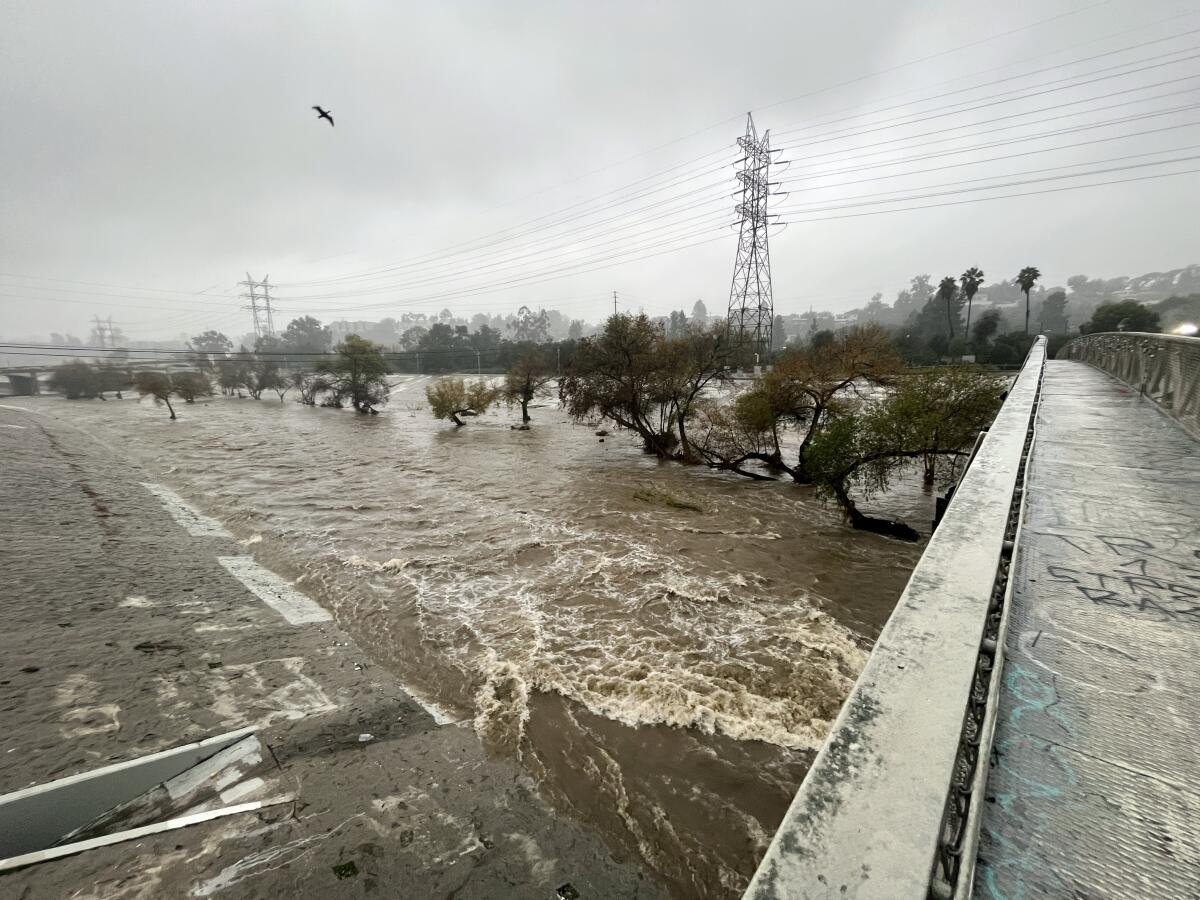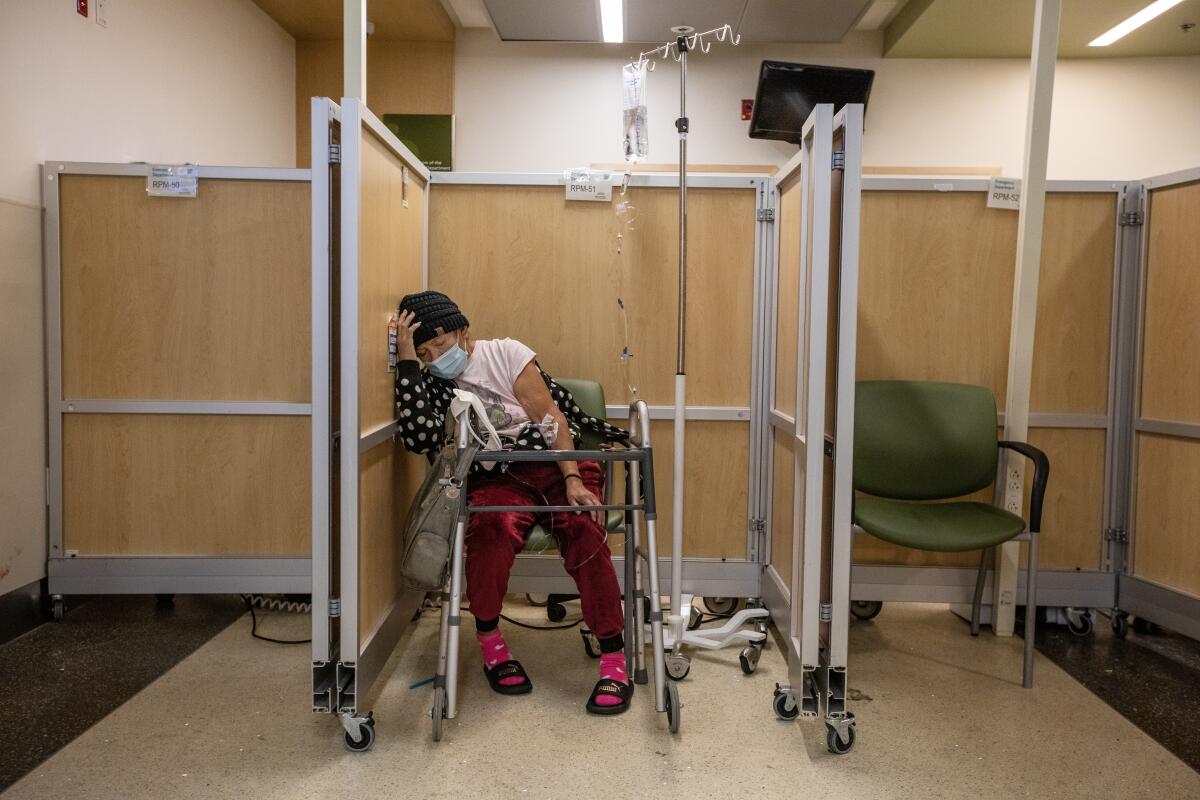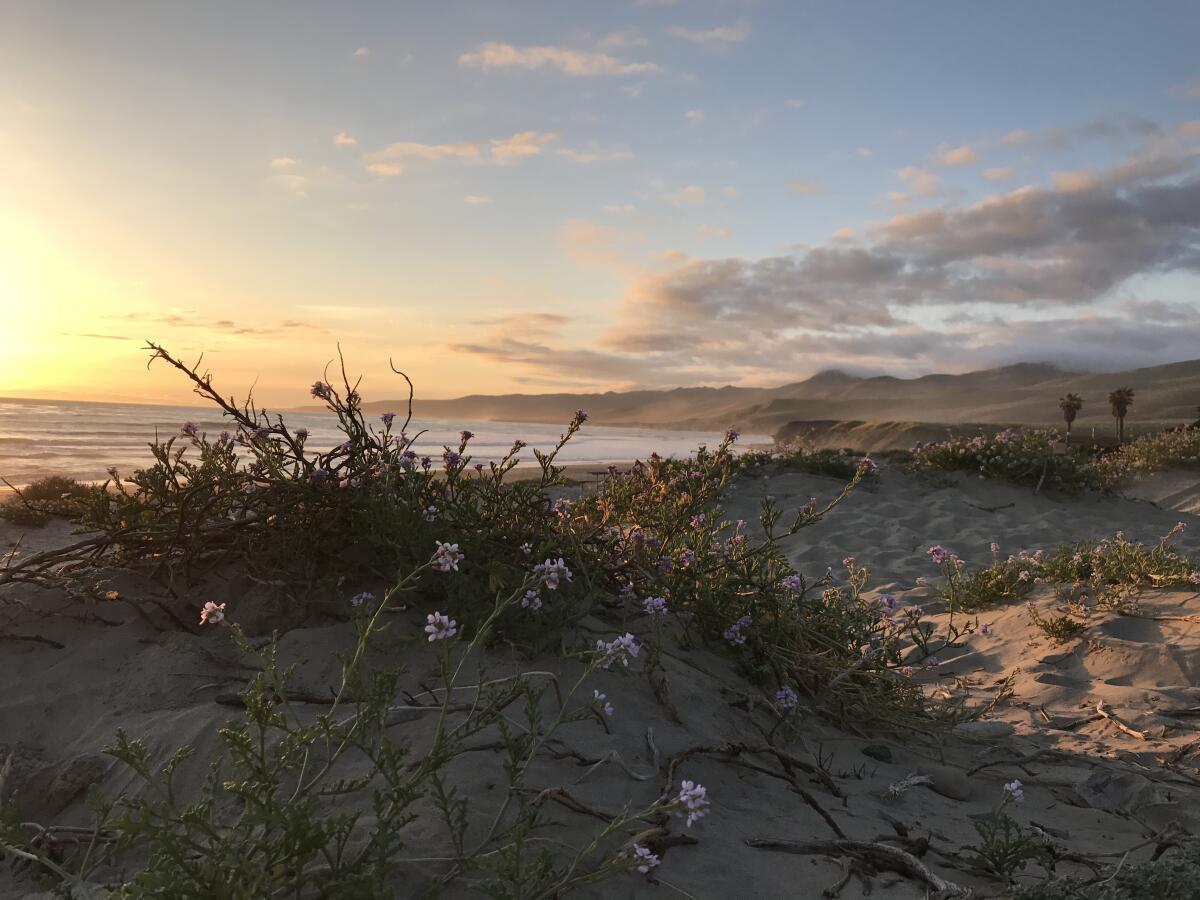What is California doing about wasted stormwater?

- Share via
Good morning, and welcome to the Essential California newsletter. It’s Tuesday, Jan. 17. I’m Ryan Fonseca, and I missed the sun. I finally felt some solar energy on my face as clouds parted above my home Monday morning.
California hadn’t seen much of the sun this year as a parade of storms blanketed much of the state, bringing record rainfall, severe flooding and at least 19 deaths.
It’s estimated that 24 trillion gallons of water have fallen on the state (not counting this weekend’s storms). But many places in California aren’t able to keep most of that free water. In Los Angeles County, for example, only about 20% of the runoff from recent storms will be captured, my colleague Hayley Smith reported.
It’s hard to determine how much stormwater is captured and reused. But according to the Pacific Institute, California’s urban areas are letting between 770,000 and 3.9 million acre-feet of water spill away every year (depending on how dry or wet the year is).
That’s a problem for our drought-laden state as officials look to modernize our infrastructure and shore up stormwater capture to save for more dry days ahead.
Californians each year use 20 trillion to 30 trillion gallons of water for agriculture, urban and environmental purposes , officials wrote in Water Supply Strategy, released in August.
With the state’s available water supply expected to shrink up to 10% by 2040, rainfall represents a vital resource that’s mostly just spilling into the Pacific.
That’s where the new strategy comes in. One goal: “create storage space for up to 4 million acre-feet of water, allowing us to capitalize on big storms when they do occur and store water for dry periods.”
One acre-foot of water, or the amount it takes to fill an acre of space one foot high, is about 326,000 gallons. So that 4 million acre-feet goal would mean about 1.3 trillion gallons.
There’s a whole lot of natural water storage space many urban areas have neglected: underground aquifers. For decades, engineers opted to build concrete drains, channels and other infrastructure designed to quickly move stormwater out of communities before it got a chance to seep into the ground.
The state is working to rectify that, aiming to expand groundwater recharge by at least 500,000 acre-feet by 2040.
One project near the city of Merced, approved last week by the State Water Board, will “enable multiple landowners to divert excess flows from Mariposa creek ... to recharge a key groundwater basin,” according to a news release.
Los Angeles has been taking steps to increase its stormwater capture, investing about $130 million and building more than 20 infrastructure projects. Department of Water and Power officials last week reported that about 10.6 billion gallons of stormwater were collected from Oct. 1 through Jan. 10.
California residents can also store rainwater — and save money in the process. Some cities (including L.A., San Diego and Sacramento) offer rebates on rain barrels, giving residents the ability to collect water during a storm and then tap that supply for lawns, gardens and other uses, instead of turning on the hose.
And now, here’s what’s happening across California.
Note: Some of the sites we link to may limit the number of stories you can access without subscribing.
L.A. STORIES
Overcrowding was an issue at South L.A.’s MLK Community Hospital before the COVID-19 pandemic. The recent rise of flu, RSV and other winter viruses has made it even worse, revealing alarming shortages for patients seeking routine care in a low-income neighborhood where most residents are Black or Latino. Los Angeles Times

L.A. Catholic schools are growing after pandemic decline. But overall enrollment is down 8.9% compared with that of fall 2019. The exodus is just part of a multi-decade decline. Los Angeles Times
Check out "The Times" podcast for essential news and more
These days, waking up to current events can be, well, daunting. If you’re seeking a more balanced news diet, “The Times” podcast is for you. Gustavo Arellano, along with a diverse set of reporters from the award-winning L.A. Times newsroom, delivers the most interesting stories from the Los Angeles Times every Monday, Wednesday and Friday. Listen and subscribe wherever you get your podcasts.
POLITICS AND GOVERNMENT
President Biden has approved federal disaster relief for California counties devastated by flooding, mudslides and landslides from recent storms. The Major Disaster Declaration aims to provide grants for temporary housing and home repairs, low-cost loans to cover uninsured property losses and other programs to help residents in Merced, Sacramento and Santa Cruz counties. The Sacramento Bee
L.A. officials will keep a downtown hotel open as homeless housing for another year. The L.A. Grand hotel had been slated to close at the end of January. The 13-story hotel set aside 480 rooms for people experiencing homelessness. As of last week, 116 of the rooms were occupied. Los Angeles Times
On a poverty tour of California, an advisor to the governor chronicles agony, anger and hope. Michael Tubbs, former mayor of Stockton, has a new mission: listen to Californians describe their struggles, defeats and hopes and actually hear them — to end poverty “by elevating the voices of people experiencing it.” Los Angeles Times
With tax season fast approaching, here’s something important to note: Californians should file a return, even if they don’t owe anything. Those who don’t could be missing out on annual refundable tax credits and one-time payments (like the recent tax relief payments) that are tied to filing status. CalMatters
CRIME, COURTS AND POLICING
Six people, including a teenage mother and her 6-month-old baby, were killed in a mass shooting in the town of Goshen near Visalia. Tulare County Sheriff Mike Boudreaux said the massacre was likely a targeted attack by a drug cartel. Two suspects being are sought. Los Angeles Times
Riverside Community College women’s basketball coach Alicia Berber has sued the school twice for Title IX violations, seeking equitable treatment for her players. She says that’s made her a target for bullying and intimidation. Berber and others now fears for her safety. Los Angeles Times
The Los Angeles Police Department released video last week showing Keenan Anderson, a 31-year-old teacher, being tased at least six times as officers held him down and handcuffed him in Venice. Anderson died at the hospital four hours later. Several policing experts reviewed the videos for The Times and said that the amount of force used by the officers seemed excessive. Los Angeles Times
Support our journalism
HEALTH AND THE ENVIRONMENT
California is bracing for one final round of storms, with a dry spell on the horizon. Once the storm clouds move on — expected Tuesday in Southern California and Thursday for Central and Northern coastal areas — state and local officials will start assessing longer-term rebuilding efforts in communities hit hard by weeks of heavy rain. Los Angeles Times
Some new residents have moved into the Bay Area in recent decades: bottlenose dolphins. The mammals are fixtures in the waters off the coast of Mexico and Southern California but have been expanding their range as parts of the Pacific have warmed up, according to a new study. This indicates that the dolphins could fare better than other species in adapting to climate change. San Francisco Chronicle
Anxiety over the “tripledemic” has some LAUSD parents pleading for a mask mandate. Worries are heightened among low-income and multifamily households — and among parents of immunocompromised children. Los Angeles Times
“Everybody was very polite, very quick and very grateful that they had an opportunity to get out and get to some dry ground.” Brittny Mejia reports on what it takes to rescue Californians stranded by recent storms. Los Angeles Times
CALIFORNIA CULTURE
San Francisco’s Bayview Park has survived many near-death experiences in the past 100 years but endures . The San Francisco Chronicle’s Peter Hartlaub explores the history of “arguably the most underrated park” in the city. San Francisco Chronicle
The rise in e-bike use is causing a rift on Orange County boardwalks. Officials in beach cities are trying to balance state climate goals that encourage biking in place of driving cars with concerns about rider and pedestrian safety. Injuries involving e-bikes have risen steadily in the county since the start of the pandemic, with hundreds of injuries reported since 2020. For some perspective, people driving cars in Orange County kill or severely injure about 875 people on average each year. Los Angeles Times
Free online games
Get our free daily crossword puzzle, sudoku, word search and arcade games in our new game center at latimes.com/games.
CALIFORNIA ALMANAC
Los Angeles: sunny, 59. San Diego: chance of showers, 56. San Francisco: sunny, 55. San Jose: patchy fog then sunny, 55. Fresno: partly sunny, 50. Sacramento: patchy fog then sunny, 51.
AND FINALLY
Today’s landmark love comes from Marie Davis of Georgetown: Jalama Beach in Santa Barbara County.

Marie writes:
To walk the dunes at Jalama Beach near Point Arguello is to join the footfalls of some of the earliest Californians. People have lived along this bountiful and beautiful coast continually for at least 9,000 years — and their Chumash children are still there. The mountains leading into the sunset mark a holy path for the ancestors. Walking there can open one with reverence and appreciation.
What are California’s essential landmarks? Fill out this form to send us your photos of a special spot in California — natural or human-made. Tell us why it’s interesting and what makes it a symbol of life in the Golden State. Please be sure to include only photos taken directly by you. Your submission could be featured in a future edition of the newsletter.
Please let us know what we can do to make this newsletter more useful to you. Send comments to [email protected].
Sign up for Essential California
The most important California stories and recommendations in your inbox every morning.
You may occasionally receive promotional content from the Los Angeles Times.




